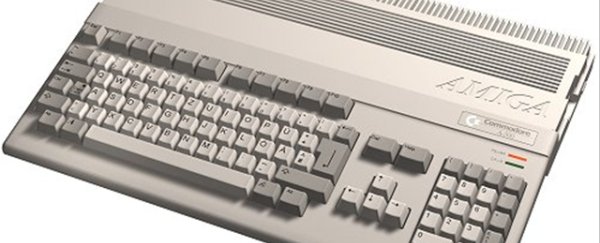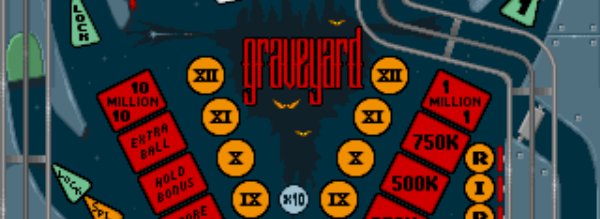Amiga Power To The People
[Doing some invoicing, I find a reference to the following. It was commissioned as part of a larger retro feature for PC Gamer which never quite came together, but stands alone well enough to lob it up here with a few tweaks. Because there's more to "PC" than IBM's descendants...]
I didn’t have a PC when I was a teenager, in the early nineties. If you’re reading this today, and are a Brit, in all probability you didn't either. You wouldn’t have been able to afford it. Any PC whatsoever was over a grand, without even considering fifteen year’s inflation.
You’d have owned an Amiga. You’d have loved it.
The Amiga was the last in a line. The PC, as it is today, is very much an American import. While it similarly originated in the old-colonies, the Amiga was actually in a distinctly British lineage – that of the true home computer (best personified by the Spectrum). It wasn’t a console. It wasn’t really like the PC. It rested somewhere between, taking from both of the worlds. With the Amiga (or Spectrum) you could try anything – not always as well as the more specialist formats, but a good enough approximation. That lead to an audience willing to take from both lineages, so leading to the joy of rampant hybridisation. In modern terms, if the Amiga would be any one game it would be Deus Ex. Point being, trying at both leads to a space neglected by the extremes.
Why was the Amiga different? Let’s take Amiga Power, the greatest videogames magazine ever crafted. No arguments accepted. If you disagree you either i) haven’t read it, ii) are the enemy. Scan across an archive of its covers and you’ll see many things you wouldn’t be surprised to see on a cover of PC Gamer – like, say, Syndicate, Frontier, flight sim Dawn Patrol, all manner of first-person shooters, adventures and so on. You’ll also see a selection of games you’d expect to see slapped on the front of a console mag – Mortal Kombat, Cool Spot, James Pond: Robocod. And then there’s a handful of games you’d have never even heard of. Take Zeewolf, a Virus-meets-Desert-Strike game of perfect physics. Until its recent PS3-remake, you could take the (brilliant) Super Stardust, an update of old-arcade classic Asteroids with the most beautiful pre-rendered rocks the world had ever seen. Hell, take at least two covers for pinball games.
Pinball games! On the cover of a games magazine!
Brilliant pinball games.
All were equal in our eyes. We bought them, snapped them open, sucked out all the marrow and were enlivened by the experiences. When I look back at the Amiga, what most impresses me is how omnivorous we were, understanding that games were games. The Amiga had an audience who implicitly understood that games were boundless, and that our shelves had hard-core wargames sitting side-by-side with the finest kid’s platformers and no-one blinked. You have to understand the difference. While if you have a PC, you can play literally everything that’s ever been made - but most don't. This fuck-it-let's-game attitude was absolutely mainstream Amiga gaming in the UK. Amiga Power wasn’t a tiny niche, but the best-selling Amiga games magazine for the majority of its existence. Its attitudes were the predominant ones, and we reveled in it. And the games reveled in it. It’s interesting to see how many future trends first germinated on the Amiga – take, for example, the Bitmap Brothers adding a harder-edge art-design sense to the classic arcade game in everything from Xenon II onwards. Just as noteworthy are all the routes unexplored. While not quite as insane as the auteur days of the Spectrum, the sheer warped thrust of the mainly British designers found fertile soil here.
In some ways you wonder if the British games industry is still trying to get over the Amiga. Many of its best developers have floundered in the years since, their quirkiness either driving them bust, alienating them from an increasing rulesbound mainstream, or ending with them being consumed by a larger publisher. Poor old DMA eaten alive and turned into the beating, anonymous fiscal heart of Rockstar, pumping the bloody GTA corpuscles about the corporate body. Lionhead’s (i.e. Bullfrog Mrk 2) sense of playfulness increasingly estranging it from the world…
It’s easy to be a little downbeat about all the things we’ve lost, but it’s important to cherish what we have now: if you’d showed Oblivion to my younger self, playing Legends of Valour with its postage-stamp-sized view window, my pulse would have rocketed to the point where my heart'd have flown out my nostrils. So while I wish there was a bit more of the anything-goes ethos around today - and I'll fully admit that part of my motivation in writing RPS is to encourage that sentiment - I don’t get too nostalgic. It’s about what I took from there. My love for games was born in the arcades and on the Spectrum, but in terms of where I spent my adolescence – metaphorically and literally – the Amiga was it. The Amiga was where I grew up and made me the gamer I am today. The attitude I take with me every time I sit down to play is the one resulting from being sealed in a Stafford bedroom with my favourite peripheral (a younger brother, essential for 2-player games), Wizkid, Populous, Putty, Monkey Island and countless others, and being left to ferment for five years. The Amiga distilled me. I’m proof.
I didn’t have a PC when I was a kid. I had an Amiga. I loved it.




